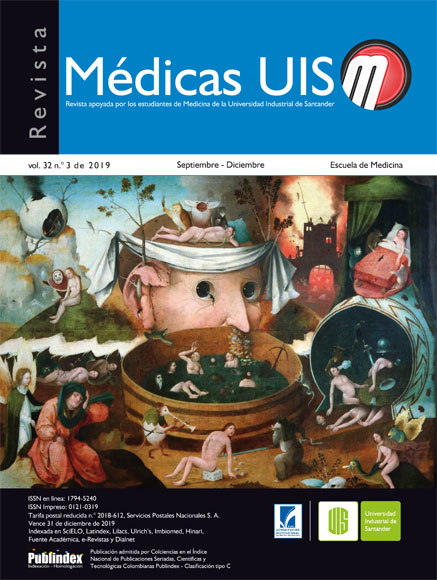Abstract
The temporomandibular joint dislocation is uncommon, but it causes a great repercussion on the facial skeleton. Occasionally, the initial symptoms can be unspecific and confuse with other pathologies if there are not an adequate knowledge of the topic and the anamnesis is incorrect. This article presents a clinical case of a patient with dysarthria and left deviation of the labial commissure, associated with severe pain and paresthesia in the right side of the face. Nevertheless, the patient initially referred ambiguous symptoms, suggesting a neurological cause. During observation in the emergency room, plastic surgery service valorated the patient, with subsequent orientation of the anamnesis and physical examination, achieving a satisfactory management of the acute dislocation. MÉD.UIS.2019;32(3):49-54
References
2. Rattan V, Rai S, Sethi A. Midline mandibulotomy for reduction of long-standing temporomandibular joint dislocation. Craniomaxillofac Trauma Reconstr. 2013;6(2):127- 32.
3. Liu F, Steinkeler A. Epidemiology, diagnosis, and treatment of temporomandibular disorders. Dent Clin North Am. 2013;57(3):465-79.
4. Prechel U, Ottl P, Ahlers OM, Neff A. The Treatment of Temporomandibular Joint Dislocation A Systematic Review. Dtsch Arztebl Int. 2018;115(5):59-64.
5. Rowe NL, Killey HC. Fractures of the facial skeleton. 2nd ed. Baltimore: Churchill Livingstone; 1969.
6. Esper RC, Ramirez FJ, Salazar MT, Sanchez JR, Morones O. Luxación temporomandibular. Rev Invest Med Sur Mex [Internet]. 2010;17(2):68-70. Disponible en: http://medicasur. com/pdf-revista/RMS124-IM01-PROTEGIDO.pdf
7. Liddell A, Perez D. Temporomandibular Joint dislocation. Oral Maxillofacial Surg Clin North Am [Internet]. 2015;27(1):125- 36. Disponible en: https://www.oralmaxsurgery.theclinics.com/ article/S1042- 699(14)00098-3/abstract
8. Rattan V. Superolateral dislocation of the mandibular condyle: Report of 2 cases and review of the literature. J Oral Maxillofac Surg [Internet]. 2002;60(11):1366-9. Disponible en: https://www.ncbi.nlm.nih.gov/pubmed/12420276
9. Akers JO, Narang R, DeChamplain R. Posterior dislocation of the mandibular condyle into the external Ear Canal. J Oral Maxillofac Surg [Internet].1982;40(6):369-70. Disponible en: https://www. ncbi.nlm.nih.gov/pubmed/6951977
10. Li Z, Li ZB, Shang ZJ, Wu ZX. An unusual type of superolateral dislocation of mandibular condyle: discussion of the causative mechanisms and clinical characteristics. J Oral Maxillofac Surg [Internet]. 009;67(2):431-5. Disponible en: https://www.ncbi. nlm.nih.gov/pubmed/19138624
11. Imai T, Machizawa M, Kobayashi M. Anterior dislocation of the intact mandibular condyle caused by fracture of the articular eminence: an unusual fracture of the temporomandibular joint apparatus. J Oral Maxillofac Surg.2011;69(4):1046-51.
12. Kahveci R, Simsek ME, Akın S, Özbek S, Özgenel GY, Gökmen ZG. Treatment of recurrent temporomandibular joint dislocation. J Maxillofac Oral Surg.2013;12(4):379-81.
13. Kotimäki J, Saarinen A. Treatment of recurrent dislocation of the temporomandibular joint with botulinum toxin: an alternative approach. Duodecim.2011;127(19):2088-91.
14. Daval M, Charrier JB. Cirugía de los traumatismos faciales. EMC Cir otorrinolaringol Cervicofac.2012;13(1):1-28.
15. Rotter BE. Temporomandibular joint disorders. En: Flint PW, Haughey BH, Lund VJ, Niparko JK, Robbins KT, Thomas JR, et al. Cummings Otolaryngology - Head and Neck Surgery. 6th ed. Philadelphia:Elsevier;2015. p.1345-52.
16. Gutierrez M. Reducción no traumática de la luxación de la articulación témporo-mandibular. Rev. Otorrinolaringol. Cir. Cabeza Cuello.2004;64:265-6
17. Taub D, Jacobs JS, Bessette RW. Treatment of disorders of the temporomandibular joint. En: Chung KC, Disa JJ, Gosain AK, Kinney BM, Rubin JP, Guyuron B, editors. Plastic Surgery,Indications and
ractice. 1st ed. Philadelphia:Elsevier; 2009. p. 591-603.
18. Loh HS. Idiopathic oromandibular dystonia causing failure of mouth closure. Br Dent J. 1983;154(9):291-2.
19. Patton DW. Recurrent subluxation of the temporomandibular joint in psychiatric illness. Br Dent J.1982;153(4):141-4.
20. Thexton A. A case of Ehler-Danlos syndrome presenting with recurrent dislocation of the temporomandibular joint. Br J Oral Surg.1965;3 (1):190-3.
21. RS, Gausche-Hill M, Bakes K, Kaji Ah, Baren JM, et al. Rosen’s Emergency Medicine: Concepts and Clinical Practice. 9th ed. Philadelphia: Elsevier; 2018.
22. Ybema A, De Bont LG, Spijkervet FK. Arthroscopic cauterization of retrodiscal tissue as a successful minimal invasive therapy in habitual temporomandibular joint luxation. Int J Oral Maxillofac Surg. 2013;42(3):376-9.
23. Bayoumi AM, Al-Sebaei MO, Mohamed KM, Al-Yamani AO, Makrami AM. Arthrocentesis followed by intra-articular autologous blood injection for the treatment of recurrent temporomandibular joint islocation. Int J Oral Maxillofac Surg. 2014;43(10):1224-8.
24. Martins WD, Ribas Mde O, Bisinelli J, França BH, Martins G. Recurrent dislocation of the temporomandibular joint: a literature review and two case reports treated with eminectomy. Cranio. 2014; 32(2): 110-7.
25. Bouguila J, Khochtali H. Treatment of recurrent temporomandibular dislocation by displacement of the zygomatic arch: a modification of Gosserez and Dautrey’s technique. Rev Stomatol Chir Maxillofac Chir Orale. 2014; 115(6): 374-6.
26. Salcedo FA. Rehabilitación oral en paciente con trastorno temporomandibular relacionado a factores oclusales. Odontol. Sanmarquina. 2013; 16(2): 38-41.
